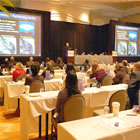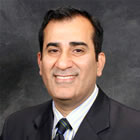|
LUMEN Course Features Transradial STEMI: Treating a Heart Attack from the Wrist
|
 |

The LUMEN
Course
in Miami, Florida |
|
February
13, 2011 --
The most dangerous type of heart attack is an ST segment Elevated
Myocardial Infarction, or STEMI. An angioplasty procedure can
open up the blocked coronary artery that is causing the heart
attack
quickly. In fact, cardiac centers have been striving for door-to-balloon
times of less than 90 minutes.
In less than two hours
from arriving at such a hospital, a patient can have his
heart attack
stopped in its tracks: damage to the heart muscle is minimized;
the recovery time is shortened; and, a future of diminished
health is no longer a sealed fate. |
The treatment of STEMI is the subject of a two-and-a-half-day
course being held in Miami, Florida on February 24-26, 2011. As Course
Director, Dr.
Sameer Mehta, explains:

Dr. Sameer
Mehta |
|
"The annual LUMEN symposium,
now in its 10th year, is constantly evolving to provide attendees
with the latest information on best clinical practices, processes
and procedures in achieving optimal outcomes for the STEMI patient.
Led by world experts, this exciting two-and-a-half day program
is a one-stop STEMI educational rendezvous for clinical and interventional
cardiologists, cardiac and vascular surgeons, ED staff, critical
care nurses, cardiovascular laboratory technologists and nurses,
paramedics, and hospital administrators." |
New this year is an emphasis on utilizing the transradial angioplasty
approach for STEMI, where access is performed through the
radial artery in the wrist instead of the femoral artery in the groin.
One reason that transradial may be useful is that the femoral access
site is more prone to bleeding complications
and
in
STEMI patients, who often are given a significant amount
of anticoagulant and antiplatelet drugs to lessen the blood clot
causing the heart attack, bleeding can become a problem. And the
transradial approach virtually eliminates bleeding
complications.
Yet, because the femoral
approach is the default access site in the United States, transradial
is performed in only 5% of cases, although in many European
and Asian centers, the wrist is used more than half the time. The
problem, discussed in many articles on Angioplasty.Org, is one of
training. Few U.S. cardiologists know how to do radial procedures.
Although the wrist approach may not be suitable for all patients,
Dr. Mehta told Angioplasty.Org, in his exclusive
interview, that the cardiology practice in the U.S.
is:
"...grossly underpenetrated in our application
of transradial STEMI
intervention.
I think theres
too much resistance, too much lack of awareness and comfort level
among
interventional cardiologists to try the transradial approach....
Transradial is not going to be for every case, but I think the penetration
should increase. The physicians that are performing STEMI interventions
should feel comfortable with both techniques.
"We understand that there is a direct correlation
between bleeding during the STEMI...and long-term
mortality. So this is not a small matter to be dismissed as a
nuisance or
something. Not only do the patients do poorly early on, but there
is even an
impact on their long-term mortality. So it's something extremely
critical and I think the control of bleeding is vital."
Dr. Mehta suggests that one strategy for lowering
the bleeding complications even further is doing
transradial and using the anticoagulant bivalirudin (Angiomax®):
"I'm convinced
that the absolutely perfect combination for a lot of these
patients is going to be transradial procedures performed with bivalirudin.
You have the access site which reduces bleeding, as well
as a
drug which is known to reduce bleeding on the basis of the
data from the
HORIZONS AMI trial. The combination probably represents the
most optimal way of performing a STEMI intervention."
The LUMEN course is being held at the JW
Marriott Marquis Miami, Thursday, February 24 through Saturday,
February 26, 2011. On Friday
morning, February 25, a two hour symposium on "Transradial
STEMI Interventions" will
be chaired by Dr. Sunil Rao and Dr. Mitch Krucoff. In the afternoon,
Dr.Tejas Patel from Ahmadabad, India, who has perhaps the world’s
most extensive experience in transradial STEMI interventions, will
lead a workshop on this technically challenging procedure. More information
can be found on the LUMEN web site, www.lumenami.com, including online
registration and an attendee brochure (PDF).
About The Radial Access Center on Angioplasty.Org
To assist in educating the professional and patient population in the U.S.
about the this technique, Angioplasty.Org created the "Radial
Access Center for Transradial Approach" in 2007, a special
section devoted to information and news about the transradial technique,
for both patients and physicians. The Radial Center features interviews with
leading practitioners of the radial technique, such as Drs. Jeffrey Popma,
Sunil Rao, Mauricio Cohen, John Coppola, Shigeru Saito and Jennifer Tremmel.
The section also maintains a
listing of upcoming training courses in the transradial approach.
For patients there is also a "Hospital
Locator" that lists U.S. centers practicing
radial angiography. As Dr. Howard Cohen of Lenox Hill Hospital
in New York says of the wrist technique, "Patients really
prefer it. 95% of people who've had it both ways would say
'I'm coming back to you, Dr. Cohen because I like this transradial
a lot better than the other way!'
Reported by Burt Cohen, February 13, 2011
|


